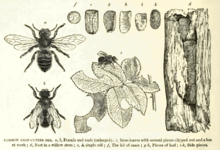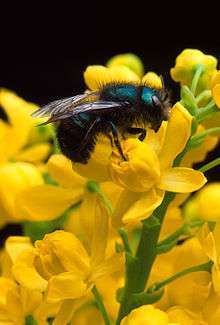Megachilidae
| Megachilidae Temporal range: Middle Eocene – recent, 45–0 Ma | |
|---|---|
 | |
| Male European wool carder bee, Anthidium manicatum | |
| Scientific classification | |
| Kingdom: | Animalia |
| Phylum: | Arthropoda |
| Class: | Insecta |
| Order: | Hymenoptera |
| Suborder: | Apocrita |
| Superfamily: | Apoidea |
| Family: | Megachilidae |
| Subfamilies | |
|
Fideliinae | |

Megachilidae is a cosmopolitan family of mostly solitary bees whose pollen-carrying structure (called a scopa) is restricted to the ventral surface of the abdomen (rather than mostly or exclusively on the hind legs as in other bee families). Megachilid genera are most commonly known as mason bees and leafcutter bees, reflecting the materials from which they build their nest cells (soil or leaves, respectively); a few collect plant or animal hairs and fibers, and are called carder bees, while others use plant resins in nest construction and are correspondingly called resin bees. All species feed on nectar and pollen, but a few are cleptoparasites (informally called "cuckoo bees"), feeding on pollen collected by other megachilid bees. Parasitic species do not possess scopae. Megachilid bees are among the world's most efficient pollinators. The motion of Megachilidae in the reproductive structures of flowers is highly energetic and swimming-like. This vigorous agitation releases large amounts of pollen. While they are efficient as pollinators, they are inefficient as foragers; megachilids require an average of ten times as many trips to flowers to gather sufficient resources to provision a single brood cell as other types of bees.
Lifecycle
Nonparasitic species

The lifecycle of nonparasitic Megachilidae is typically that nests are built, divided into cells. Each cell receives a supply of food (pollen or a pollen/nectar mix) and an egg; after finding a suitable spot (often near where she emerged), a female starts building a first cell, stocks it, and oviposits. She builds a wall that separates the completed cell from the next one. The larva hatches from the egg and consumes the food supply. After moulting a few times, it spins a cocoon and pupates. It emerges from the nest as an adult. Males die shortly after mating, but females survive for another few weeks, during which they build new nests.
Nests are often built in natural or artificial cavities. Some embed individual cells in a mass of clay or resin attached to a wall, rock surface, or plant stem. Nest cavities are often linear, for example in hollow plant stems, but not always (snail shells are used by some Osmia, and some species readily use irregular cavities).
Parasitic species
Some genera of megachilids are brood parasites, so have no ventral scopa (e.g. Stelis and Coelioxys). They often parasitize related taxa. They typically enter the nest before it is sealed and lay their eggs in a cell. After hatching, the parasite larva kills the host larva, unless the female parasite has already done so, and then consumes the provisions. Parasitic species are of equal size or smaller than their victims. In 1921, the journal American Museum Novitates published a preliminary report on parasitic megachilid bees of the western United States.[1]
Diversity
North America has many native megachilid species, but alfalfa leafcutter bees (Megachile rotundata) are an imported species used for pollination. The most significant native species is Osmia lignaria (the orchard mason bee or blue orchard bee), which is sold commercially for use in orchard crop pollination, and which can be attracted to nest in wooden blocks with holes drilled in them (which are also sold commercially for this purpose). Anthidium manicatum, also known as the European wool carder bee, is another species within the Megachilidae family. Rather than cutting leaves or petals, however, A. manicatum scrapes the hairs from leaves to use for nesting material, a behavior that is atypical in Megachilidae bees.[2]
Evolution and taxonomy



The fossil record for megachilid bees is poor, but a Middle Eocene dicotyledonous leaf shows definite semicircular cutouts along its margin, implying that leaf-cutting bees existed at that time.[3] Multiply-cut leaves and rare body fossils from the Eocene of Germany and the Paleocene of France suggest that Megachilinae began cutting leaves early in their evolution.[4] Phylogenetic analysis yields an age consistent with this Eocene origin for the group.[5]
- Subfamily Fideliinae
- Tribe Pararhophitini
- Pararhophites
- Tribe Fideliini
- Fidelia
- Neofidelia
- Tribe Pararhophitini
- Subfamily Megachilinae
- Tribe Lithurgini
- Lithurgus
- Microthurge
- Trichothurgus
- Tribe Osmiini
- Afroheriades
- Ashmeadiella
- Atoposmia
- Bekilia
- Chelostoma
- Haetosmia
- Heriades species have narrow abdominal bands. They resemble small Osmia, but they are oligolectic (specialized on a few subfamilies of Asteraceae) and use resin from conifers, as well as plant fibers and sand, as cell wall material.
- Hofferia
- Hoplitis
- Hoplosmia
- Noteriades
- Ochreriades
- Osmia
- Othinosmia
- Protosmia
- Pseudoheriades
- Stenoheriades
- Stenosmia
- Wainia
- Xeroheriades
- Tribe Anthidiini
- Acedanthidium
- Afranthidium
- Afrostelis
- Anthidiellum
- Anthidioma
- Anthidium
- Anthodioctes
- Apianthidium
- Aspidosmia
- Austrostelis
- Aztecanthidium
- Bathanthidium
- Benanthis
- Cyphanthidium
- Dianthidium
- Duckeanthidium
- Eoanthidium
- Epanthidium
- Euaspis
- Gnathanthidium
- Hoplostelis
- Hypanthidioides
- Hypanthidium
- Icteranthidium
- Indanthidium
- Larinostelis
- Neanthidium
- Notanthidium
- Pachyanthidium
- Paranthidium
- Plesianthidium
- Pseudoanthidium
- Rhodanthidium
- Serapista
- Stelis Panzer and related genera (stelidine bees) are cleptoparasites on other Megachilidae. They belong to the tribe Anthidiini. Bees in the subgenus Heterostelis are parasitic on Trachusa.
- Trachusa
- Trachusoides
- Xenostelis
- Tribe Dioxyini
- Tribe Megachilini
- incertae sedis
- Neochalicodoma
- Stellenigris
- Tribe Lithurgini
References
- ↑ Cockerell, Theodore; Lutz, Frank Eugene (1 December 1921). "Some parasitic megachilid bees of the western United States" (PDF). American Museum Novitates. 21. Retrieved 5 October 2014.
- ↑ Michener, C. D. (2000). Bees of the World. Baltimore: Johns Hopkins University Press. p. 913.
- ↑ Victor H. (June 2008). Phylogeny and Classification of the Bee Tribe Megachilini (Hymenoptera: Apoidea, Megachilidae), with Emphasis on the Genus Megachile. UMI 3316016. ProQuest / University of Kansas (PhD thesis). pp. 54–56. ISBN 978-0-549-68378-0.
- ↑ Wedmann, Soni a; Wappler, Torsten; Engel, Michael S. (June 2009). "Direct and indirect fossil records of megachilid bees from the Paleogene of Central Europe (Hymenoptera: Megachilidae)". Naturwissenschaften. 96 (6): 703–712. PMID 19296064. doi:10.1007/s00114-009-0525-x.
- ↑ Cardinal, Sophie; Danforth, Bryan N. (January 2013). "Bees diversified in the age of eudicots". Proceedings of the Royal Society B: Biological Sciences. 280: 20122686. PMC 3574388
 . PMID 23363629. doi:10.1098/rspb.2012.2686.
. PMID 23363629. doi:10.1098/rspb.2012.2686.
External links
| Wikimedia Commons has media related to Megachilidae. |
- Palaearctic Osmiine Bees
- Leafcutting bees on the UF / IFAS Featured Creatures Web site
- Online Guides to all the eastern North American Megachilidae
- Bugguide. Information and photos of Megachilidae of North America
